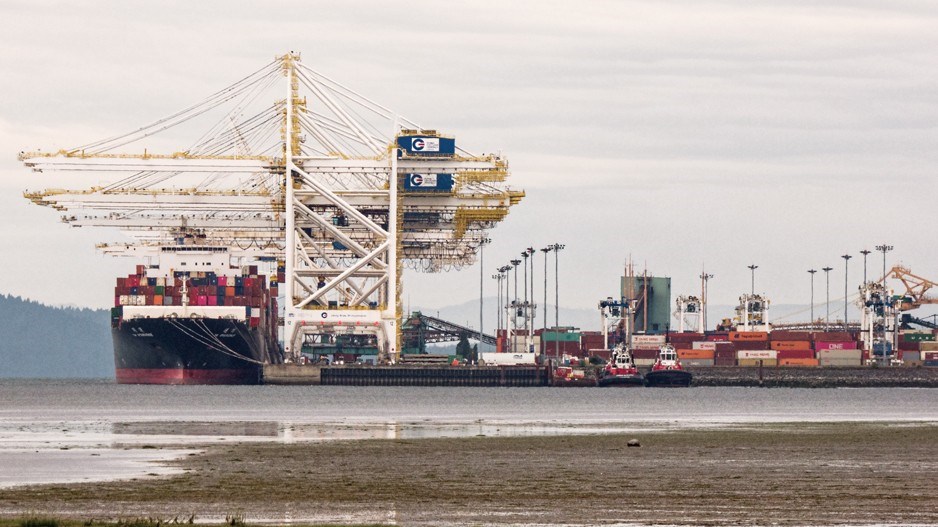The Vancouver Fraser Port Authority is now searching for a construction company to plan and build the Roberts Bank Terminal 2 container port project wharf and landside facilities.
The port said Wednesday the state-of-the-art marine container terminal at the Port of Vancouver will support Canada’s trade diversification goals by unlocking over $100 billion in new trade capacity and contributing $3 billion in GDP annually.
The project would be a three-berth marine container terminal in Delta. Construction is planned to begin in 2028, and the terminal is expected to be in operation by the mid-2030s.
The project, to be located next to the existing Deltaport and Westshore Terminals, is planned to provide an additional 2.4 million 20-foot equivalent units of container capacity per year, said the federal minister of environment’s April 2023 decision statement on an environmental assessment.
Port CFO Victor Pang told BIV Terminal 2 is expected to become a regional economic driver by generating more than 18,000 construction jobs and 17,000 well-paying long-term jobs annually during operation.
The port authority has signed mutual benefits agreements with 27 First Nations, who have provided consent for the project to proceed.
“It will also create lasting benefits for the community of Delta through the $6 million Roberts Bank Terminal 2 community legacy fund, which will launch this summer,” the Vancouver Fraser Port Authority said.
The port authority has pledged continued consultation and collaboration with First Nations on economic development opportunities, including Indigenous procurement, contracting and employment opportunities.
Following the federal and provincial governments’ 2023 approval of the project, the port authority submitted a Species at Risk Act-compliant Fisheries Act authorization application in 2024.
A decision on that, the final major permit, is expected no later than October 2026, the port authority said.
In collaboration with First Nations, the port authority has committed to restoring more than 94 hectares of offsetting habitat in collaboration with First Nations, to protect priority species like juvenile Chinook salmon and Dungeness crab.
Many of the projects in this plan were selected based on First Nations’ priorities. This includes a habitat enhancement project on Tilbury Island, which is a priority project for the Musqueam Indian Band and Tsawwassen First Nation that will increase marsh habitat and provide ecological benefits.
Still, the federal minister said in 2023 that “the significant adverse environmental effects” the project is likely to cause are justified in the circumstances. Multiple conditions were put on that approval.
The port authority said, that to move the environmental plan forward, the contract to be awarded also includes the construction of a marine terminal fish passage to support juvenile salmon migration, and the civil works for onsite habitat enhancement and the South Arm Jetty Tidal Marsh Project.
“[It] remains a priority project for First Nations to benefit fish and wildlife,” the port authority said.
Pang said the terminal will be a catalyst for economic transformation nationally. He said it aims to support Prairie grain exports and B.C.’s forestry sector, as well as supporting communities depending on reliable and affordable access to essential goods on store shelves.
“To meet Canada’s needs in today’s quickly evolving trade landscape, we have accelerated our efforts to deliver Roberts Bank Terminal—a project that will strengthen Canada’s economic security and deliver trade resilience,” Pang said.
As part of a competitive selection process for the landmass and wharf component of the project, the port authority has selected what it calls a progressive design-build procurement with target price model. An independent fairness monitor has been appointed to oversee the fairness of the process.
Pang told BIV the landmass work includes building further over the water to expand the operating footprint.
The contract includes the delivery of an approximately 100-hectare marine landmass, 35-hectare widened causeway, 1,300-metre wharf structure and berth pocket, and expanded tug basin.
While there had been concerns in the past about rail infrastructure expansion impacting the local Agricultural Land Reserve, Pang said those requirements have already been completed.
Pang said the request for qualifications marks the first step in the procurement process with interested construction teams asked to provide an interim submission confirming their interest by Sept. 18, 2025, with details of qualifications due a week later.
The port authority will shortlist three teams this fall, who will then be invited to submit a proposal.
The port said additional procurement opportunities will come available in the future, including specialist sub-contracting and material supply for the landmass and wharf sub-contracts, and a terminal concession procurement in the late-2020s to select the operator that will build, equip and operate the new terminal.
To view the procurement documents and respond to the request for qualifications, visit the BC Bid website.
A project information session will be held in Vancouver July 22.



